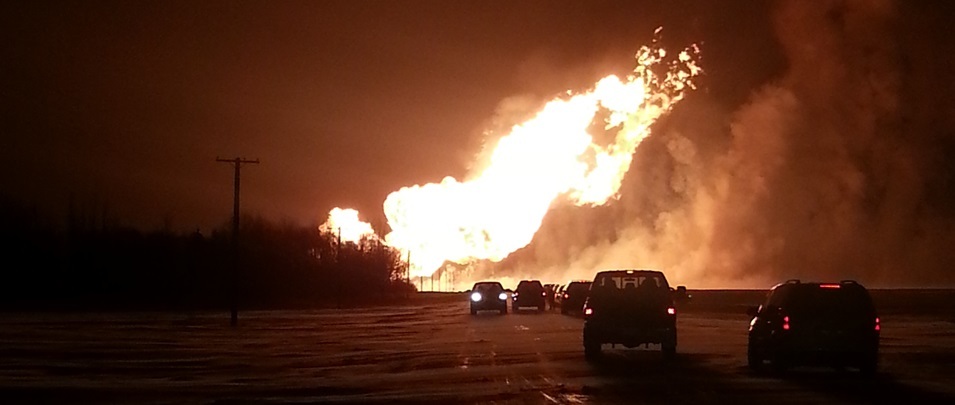
The events of January 25, 2014 still remain fresh in the memories of many residents of southeastern Manitoba. Just after midnight on that fateful Saturday, a natural gas pipeline near Otterburne exploded, leaving about 4,000 people without heat for days on end.
As if the sights and sounds of such a catastrophe weren’t remarkable enough, the event took place in the middle of one of the coldest winters on record. On this weekend, temperatures plunged toward -30ºC, with windchills hovering around -40ºC.
At 1:05 a.m. that Saturday, local RCMP arrived on the scene of the accident near the corner of Highway 59 and Highway 303, responding to the sound of a loud explosion. Neighbours were awoken by the cacophony and watched from their windows in awe as 500- to 600-foot flames shot into the sky.
Students from nearby Providence College watched from campus, speculating that a massive greenhouse in the area had gone up in flames again. One year prior, almost to the day, a massive greenhouse operation in that area suffered $6 million in damages after a fire broke out.
The ball of fire from the 2014 pipeline break lit up the night sky to such a degree that it created an effect akin to sunset for many miles around.
Fourteen kilometres to the north, in Niverville, residents Allan and Brenda Sawatzky were snapping photos at their south-facing window, struck by the enormity of the orange glow.
The explosion had been so intense that debris landed up to 300 feet away. It created a crater 75 feet long by 37.5 feet wide.
The RCMP evacuated residents from five nearby homes. No injuries were reported.
One day prior, a special weather advisory had been released by Environment Canada which would affect most of southern Manitoba. A strong arctic cold front was expected to bring 80 kilometre per hour winds, poor visibility, and windchills of -40ºC.
Crisis Response
Crews from TransCanada Pipelines (TCPL, now known as TC Energy) were quickly called in to assess the situation and close off the fuel source in two major gas lines. It took 12 hours for the flames at the pipeline break to be extinguished.
Île-des-Chênes resident Dan Vermette lives not far from the natural gas pumping station where crews worked. Vermette tells The Citizen that he awoke on Saturday morning unaware of the explosion. Instead he was drawn outside by a loud whistling sound that reminded him of a Boeing 747 flying directly overhead.
“I could hear it through my [closed] windows,” says Vermette. “And when I stepped outside, my neighbour was out and we couldn’t even communicate.”
The noise continued for the better part of a day, caused by workers venting the lines at the TCPL pumping station in order to close the valves.
As the gas lines were shut down, homes heated with gas furnaces lost service. Gas hot water tanks were rendered useless.
By Saturday morning, Manitoba Hydro issued an advisory to all its customers in the southeast. Communities serviced by the damaged pipeline included New Bothwell, Niverville, Ste. Agathe, and six others further south.
Residents were advised to use space heaters approved for indoor use and conserve electricity wherever possible. It was also recommended that families shut off the water supply to their homes if they had to leave during the outage.
“No estimate for the resumption of supply has been received from TCPL,” the advisory stated. “Manitoba Hydro is advising customers to prepare for a gas outage for a minimum of one day.”
Day 1: Cold Reality Hits Home
Bryan Trottier, owner of Trotco Electric in Niverville, says that he learned of the impending gas outage before his own home’s gas furnace quit heating.
“A Hydro guy phoned me early in the morning on Saturday and said, ‘Get your crews ready. There’s no gas because the gas line exploded… [so] get some heaters. This is pretty serious and it’s going to last quite a few days,’” Trottier says.
Trottier did just that. He mobilized a team of approximately ten electricians, recognizing that about half of the community’s homes were serviced by gas. One of his employees was sent out to procure as many household space heaters as he could purchase. He returned with an entire truckload.
Meanwhile, Trottier spent the day in his company office taking calls from panicked homeowners.
“I’d be on the phone and have another call on hold,” Trottier says. “Then I’d have voicemails when I was done. I had one guy sitting next to me just writing down the addresses.”
For the next ten hours or so, Trottier’s crew kept busy by installing breakers and space heaters near household furnaces where the heat could circulate throughout the house via the return air system.
“Originally we started installing two five-kilowatt heaters in every house, and then me and my Hydro buddy started doing some calculations,” Trottier says. “We realized that the main [electricity] transmission line wouldn’t take that [load].”
One heater per household, they decided, would be enough to keep a house’s temperature hovering around 16 degrees Celsius, warm enough to keep pipes from freezing. Homeowners would have to get creative for anything more.
By late Saturday, Trottier’s crew had installed 75 percent of the heaters they’d collected. Early on Sunday morning, they began all over again.
Day 2: State of Emergency
By Sunday, the RM of Hanover had declared a local state of emergency. Manitoba’s Emergency Measures teams were out helping communities like Niverville, New Bothwell, and Ste. Agathe set up warming shelters to give families a place in which to retreat.
Meanwhile, TCPL sent out trucks containing compressed natural gas to metering stations in the southeast which would supply critical services such as personal care homes and hospitals, as well as schools or churches being used as emergency warming centres.
The company also set up temporary headquarters within Niverville where residents could turn in receipts for space heaters, electrical services, hotel stays, and other costs incurred due to the inconvenience. They were reimbursed on the spot.
Local farmers were able to make claims for livestock losses.
At ground zero, officials from the National Energy Board and the Transportation Safety Board were running inspections on the pipeline to try and determine the cause of the incident.
Day 3: Repairs Underway
Monday, January 27, marked the third day of which thousands of customers had been without heat while temperatures continued to plummet. Affected schools and businesses remained closed.
One news agency reported that by Monday morning temperatures had dropped to -32ºC with a windchill of -45ºC.
Pipeline workers were called in from far and wide to expedite. It was in these high wind, bone-chilling conditions that work got underway.
Riley Laurencelle worked for Somerville Pipelines, a subcontractor to TCPL. His crew was on a job site in Thunder Bay when they received the call to drop everything and head to Otterburne.
“When that pipeline blew up, we worked 48 hours straight to get it back up and running so everyone with gas in the surrounding communities could have heat,” Laurencelle says. “It was close to -30ºC [when we arrived] and it was a very interesting job.”
Late Monday, Trottier received a phone call from a crew at ground zero, requesting immediate electrical assistance in getting warming huts wired up for the crews working there.
“I went out there at like 10:00 on Monday night,” Trottier says. “It was brutally cold. I think it was minus -38ºC that night. We were working a few hundred yards away from the actual break, but it was like a scene from a movie. It was all lit up and there was a big hole and people working in there. They wouldn’t let you get close. The security was pretty tight.”
A number of his electrical technicians continued work at ground zero over the next few days. Security was so tight that the workers waited in their vehicles for up to eight hours before they were approved for access.
“Generally, a site is just secured from a safety perspective,” says Reid Feist, media relations manager for TC Energy (TCPL). “Ultimately, we have accountability for people on our sites so… it’s very standard for us to have a containment zone. It’s just basically so we can account for everybody all the time. If something happens in response to the incident, then you have a sense of who’s there.”
All in all, he adds, there were around 300 people at ground zero throughout the course of the event, there to inspect, repair, monitor, and document.
Day 4+: Gas Restored, Cause Revealed
In total, approximately 80 hours passed from the initial gas shutoff to the point when the gas flow was restored.
Even after the lines opened up, many Manitoba Hydro customers had to wait for Hydro staff to attend their homes and relight their furnace pilot lights.
It wasn’t until July 2015 that reports had been compiled and the cause of the gas line rupture went public.
According to the Transportation Safety Board (TSB) of Canada, a crack in the weld at a mainline valve assembly had given way, causing the sudden and powerful release of gas.
It was believed that the crack had been there since the time of the pipeline’s construction 50 years prior. At the time, the report stated, there was no requirement to inspect welding quality.
Davis Sheremata, external communications and media relations person for TCPL at the time, said that a number of factors led to the Otterburne explosion.
“The TSB has found that the weld, which led to the incident, had safely operated for more than 50 years,” Sheremata said. “However, an unprecedented combination of circumstances including extreme frost, heavy equipment in the area, and the absence of gas flow in the line for 20 days likely caused the fracture.”
According to Feist, it was an isolated crack.
“We did some testing along the rest of the line and didn’t find anything similar, so it was thankfully something unique in the system.”
Another news outlet, Vice News, went on to investigate TCPL’s track record of incidents similar to the one that occurred in Otterburne.
This natural gas explosion was the sixth such event in Manitoba since 1994 and the fourth to occur on a TCPL line.
“TransCanada, the same company that wants to build the Keystone XL and Energy East pipelines, has tallied more than 300 ‘reportable incidents,’ including ruptures, leaks, fires, explosions, serious injuries, and one death, at its facilities since 2008,” read a Vice article in 2015.1
Another pipeline explosion occurred one year after the Otterburne event. This one happened on September 15, 2015, at the St. Vincent Compressor Station in Kittson County, Minnesota, just across the border from Ridgeville, Manitoba.
Based on available stats from 2018, TC Energy (TCPL) operates more than 93,000 kilometres of pipeline across Canada and the U.S. Of that, 2,500 kilometres of pipeline stretches across Manitoba, supplying gas to Canada’s east coast and the United States.
The company employs 62 Manitobans and contributes almost $21 million to local property taxes. They’ve invested in communities surrounding their pipeline projects to the tune of $182,000.
Residents Remember
During that cold week in 2014, Kim Georgison of Niverville felt extra thankful to have the supplemental heat from a wood-burning fireplace. But, she says, finding a local store with space heaters in stock was difficult.
One of Georgison’s biggest takeaways was the way in which the emergency brought neighbours and the community closer together. Social media lit up with homeowners who had heat inviting families with no heat to take up residence in their homes or just stop in for a coffee and a warm-up.
For Georgison, this benevolent spirit echoed experiences she’d had in 1997, during the Red River’s flood of the century.
“I was living on Highway 200 during the ‘97 flood,” says Georgison. “It was both the worst and best time of my life. People rose to the occasion and opened their doors, wallets, and hearts to help. It restored my faith in people. I saw the same type of giving, on a smaller scale, during this time, so it wasn’t all bad.”
Myron Dyck, Niverville’s current mayor, was a town councillor in 2014, actively invested in helping set up the community’s warming shelter at the Heritage Centre. He echoes Georgison’s sentiments about that time.
“Interestingly enough, no one used [the shelter],” Dyck says. “There was a great show of community by our residents. Those who were impacted were able to be taken in by friends, families, and neighbours, with stories of camping out in the living room as residents opened their homes. I think about this and it brings a warm feeling to my heart. Those days were community. Those days represented what Niverville is: a place where people are willing to help others in their time of need.”
Also from Niverville, Kenzie Prudhomme looks back at the event as a kind of fun adventure.
“Luckily, we could borrow a couple of electric heaters,” Prudhomme says. “We sealed off our most used room and just tried to heat our main space. The biggest issue for us was water. We heated it up like we were camping. Showers were had in the city at my parents’ place.”
Like many others, the Prudhomme family took advantage of oven heat to add some comfort in their reduced living space.
The “fun” part of the adventure ended for Prudhomme, though, by day three when her electrical power also went out. The couple drained their water lines and began to pack up to leave.
Thankfully, the power was restored a few hours later.
Krista Carswell Shidel and her family were among those to lose both their gas and electricity on night three. Shidel and her partner had five children, the oldest of which was seven. They also had six-week-old twins.
“We managed without gas, as we had heaters, but when the power went out we had no way to heat bottles or sanitize baby supplies properly,” says Shidel. “Triple sleepers and extra blankets didn’t cut it through the day’ so we headed to Winnipeg to my parents’ house. [It was a] crazy time! We were only five months in Niverville.”
Amanda Exner of Niverville worked for Manitoba Hydro during the gas outage. She has no recall of any electrical power outages at the time but says it is altogether possible.
“We monitored closely to make sure the power grid didn’t overload with all the extra space heaters [and things] running,” Exner says. “I honestly believe [the electrical outage] was an isolated issue. Fuses or transformers can blow when overloaded.”
Trottier agrees, saying that he remembers warning people about just such a possibility.
“I was putting warnings on Facebook about that,” Trottier says. “If everyone lives very comfortably for the next few days, we’re all going to have no power.”
For Trottier and so many others, an overarching feeling of nostalgia returns when recalling those days back in 2014.
“That’s my favourite kind of work, helping people when they’re in need,” Trottier says. “It’s exciting and you feel like you’re making a difference, you know? So I thoroughly enjoy disasters, as long as people aren’t getting hurt.”
Sawatzky has another outlook on the event which rendered his gas furnace and hot water tank inoperable during those chilly days.
Confronted by a news reporter visiting Niverville the morning following the explosion, he was asked whether he felt fear when witnessing the massive flames from his kitchen window.
“It wouldn’t be the first time I thought it was the end of the world, and then realized it was just gas,” Sawatzky jokes.



















